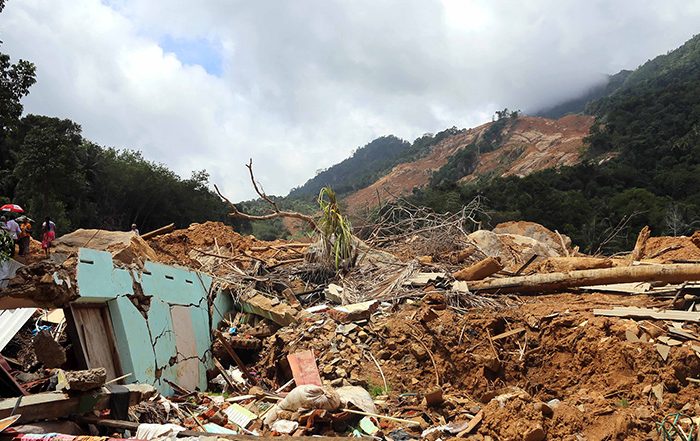
Disasters explained: Landslides
Landslides kill thousands of people around the world every year. Learn more about landslides and why they happen.
An avalanche is a mass of material moving rapidly down a slope.
Snow avalanches are the most common, occurring in mountainous areas such as Europe and North America.
Keep reading to learn more about what causes an avalanche, the different types of avalanches, the deadliest disasters on record and more.
Although we have never needed to respond to an avalanche, ShelterBox provides emergency shelter following different types of disasters.
A snow avalanche happens when a large mass of snow suddenly moves downhill. These usually occur during winter, but they can be triggered any time during the year.
For an avalanche to occur, three elements are needed: a surface bed of snow, a weaker layer that is collapsible, and an overlaying snow slab. It’s very common for an avalanche to happen during and immediately after a snowstorm.
Storms, temperature, wind, slope steepness, terrain, vegetation, and general snowpack conditions can all influence the possibility of an avalanche happening.
But humans can also often trigger avalanches. When somebody walks or rides over a slab with an underlying weak layer, it causes the weak layer to collapse. As a result, the overlaying mass of snow fractures and start to slide, causing an avalanche.
Watch as our CEO talks about the Turkey avalanches that took place in 2020.
90% of avalanche incidents involving people are triggered by the victim or someone in the victim’s party.
Source: National Geographic
Sluffs and slabs are the two main types of snow avalanches.
Sluff avalanches occur when the weak layer of a snowpack is on the top.
A slab avalanche is a lot more dangerous, and it occurs when the weak layer lies lower down in a snowpack.
This layer is covered with other layers of compressed snow. The weak layer breaks off once the avalanche is triggered, pulling all the layers on top of it down the slope. These layers tumble and fall in a giant block, or slab.
Once a slab avalanche starts, the slab shatters into many separate blocks. These snow blocks break up into smaller pieces. Some of the pieces rise into the air as a moving cloud of icy particles.
The cloud races downhill at very high speeds.
These are especially threatening to people skiing, hiking or snowboarding because of their thickness and speed. Each year, over 150 people are killed because of avalanches worldwide.
Source: National Geographic
Experts and scientists try to predict when an avalanche is going to occur using historical data, weather information and data on the actual snow on a mountainside. However, it’s still not possible to predict with 100% certainty when and where they will occur.
One of the most effective ways to prevent an avalanche is to simply cause one. Avalanches can be triggered deliberately in order to prevent the snow building up.
According to Guinness World Records, the deadliest avalanche on record took place on 13 December 1916, near the Gran Poz summit of Monte Marmolada, Italy.
That day became known as White Friday after thousands of soldiers from Austria-Hungary and Italy were killed by a number of avalanches in the Dolomites.
Other deadly avalanches that have happened during the years are:
– Yungay, Peru. An avalanche on Mount Huascaran, Peru, buried the town of Yungay in snow and ice in May 1970. The incident killed approximately 18,000 people.
– North Ossetia, Russia. At least 125 people were killed as the Kolka glacier collapsed on the Russian village of Nijni Karmadon in September 2010.
– Salang Avalanches, Hindu Kush, Afghanistan. 17 avalanches buried more than 2 miles of highway and killed nearly 172 people in February of 2010. These were triggered by heavy winds and rain and began at the southern approaches of the Salang Pass in the Hindu Kush Mountain range.
Sources and references: National Geographic, The Independent, BBC, Guinness World Records, Britannica